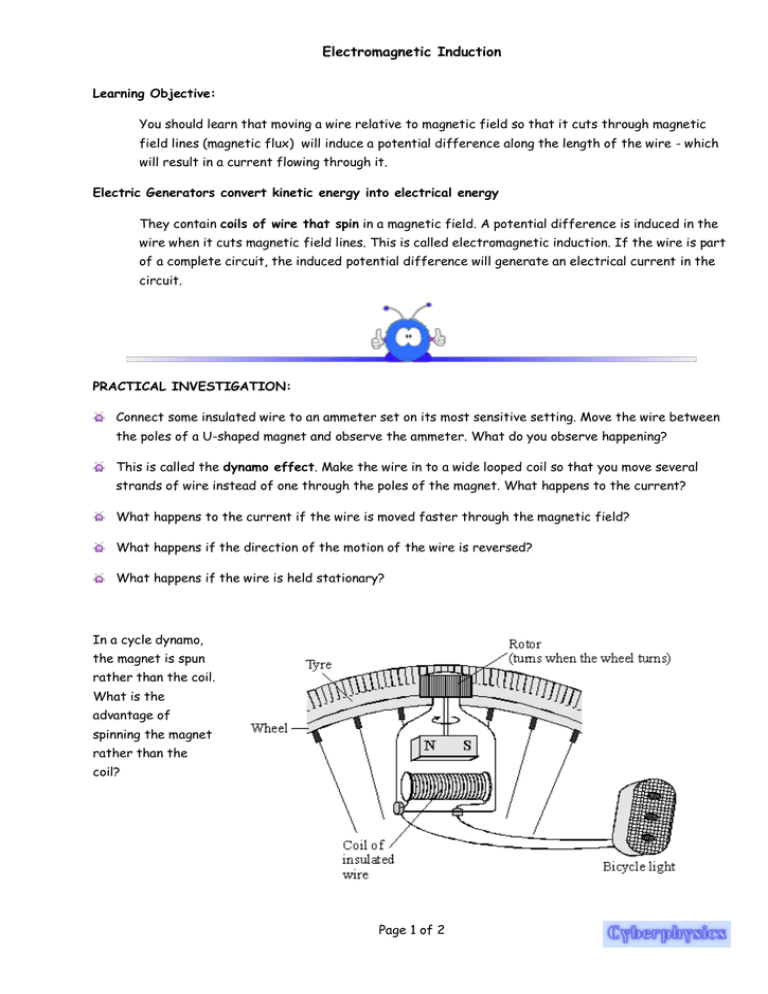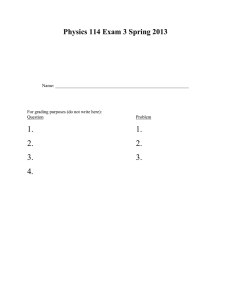a worksheet
advertisement

Electromagnetic Induction Learning Objective: You should learn that moving a wire relative to magnetic field so that it cuts through magnetic field lines (magnetic flux) will induce a potential difference along the length of the wire - which will result in a current flowing through it. Electric Generators convert kinetic energy into electrical energy They contain coils of wire that spin in a magnetic field. A potential difference is induced in the wire when it cuts magnetic field lines. This is called electromagnetic induction. If the wire is part of a complete circuit, the induced potential difference will generate an electrical current in the circuit. PRACTICAL INVESTIGATION: Connect some insulated wire to an ammeter set on its most sensitive setting. Move the wire between the poles of a U-shaped magnet and observe the ammeter. What do you observe happening? This is called the dynamo effect. Make the wire in to a wide looped coil so that you move several strands of wire instead of one through the poles of the magnet. What happens to the current? What happens to the current if the wire is moved faster through the magnetic field? What happens if the direction of the motion of the wire is reversed? What happens if the wire is held stationary? In a cycle dynamo, the magnet is spun rather than the coil. What is the advantage of spinning the magnet rather than the coil? Page 1 of 2 Electromagnetic Induction THE ALTERNATING CURRENT GENERATOR: The two slip rings rotate in tandem with the armature as it is turned. Fixed carbon brushes electrically connect the armature to the external circuit throughout the rotation. When the armature at the vertical position the flux lines are parallel to the coil wire. No magnetic flux is cut and hence no induced p.d. and therefore no induced current.. When the armature rotates to the horizontal position, the rate of cutting of magnetic flux increases and the induced p.d. and therefore current increases until its maximum value at the horizontal position. The direction of the induced current can be determined from Fleming's Right Hand rule. As the armature continues on its rotation, the rate of cutting of magnetic flux decreases until at the vertical position it is zero. We have now done half a turn of the coil. Subsequently upon reaching the horizontal position again, the induced current is maximum, but the direction of the induced current flowing through the external circuit is reversed. The direction of the induced current (which flows through the external circuit) keeps changing depending on the orientation of the armature. This induced current is also known as alternating current. The current is positive (+) in one direction and negative in the other (-). The smooth rings play a critical role in the generation of alternating current. Here are two Java applets for you to look at: http://www.walter-fendt.de/ph14e/generator_e.htm http://micro.magnet.fsu.edu/electromag/java/generator/ac.html The faster the coil rotates the shorter the time period of rotation - but also the faster the rate of flux cutting so the greater the maximum p.d. produced.... and this info could form an ideal question for examiners to ask! Page 2 of 2


